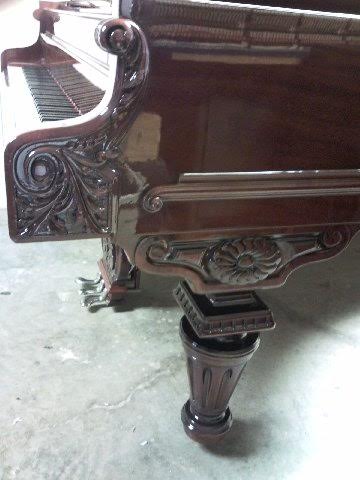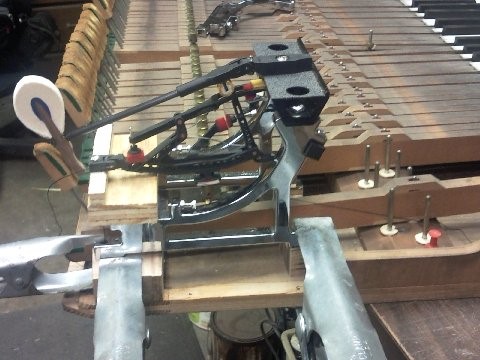By Bruce Clark, Lead Engineer, Wessell, Nickel & Gross
Story taken from Piano Technicians Journal / July 2012
At Wessel, Nickel & Gross we agree with much that Anne Acker asserts in her comments on Chuck Behm’s Weber restoration series.
Various approaches are available for those who make their living rebuilding pianos. At one end of the spectrum are those who view an old piano as simply the raw material for their next creation. In some ways this group resembles the traditional piano maker more than one who refurbishes. This group is typified by those who rescale the old piano, or correct touch resistance problems, or who redesign the soundboard by changing the ribbing and adding cutoff bars. Whether or not one agrees with the choices made by any particular rebuilder, the goal is to get the best possible performance from the piano at the end of the rebuilding process. Whether or not the final product bears any resemblance to the original is of little concern in this style of rebuilding.
At the other end of the spectrum are those, such as Anne Acker, who provide “conservation-oriented restoration.” I take this to be much like a museum restoration in that historical accuracy and authenticity are the paramount values. Practitioners of the restoration approach strive to keep as much of the old as possible while restoring the rest of the instrument to a functional level. The goal is to keep the instrument as a historically accurate representative of the intentions of its manufacturer.
Most actual rebuilders fall somewhere between these two examples. Often only the most egregious problems will be corrected, sometimes for conservation, sometimes because of economic reasons.
Typically, rebuilding customers choose the style of rebuilding through their choice of rebuilders. If one wanted a museum-style restoration it wouldn’t make sense to choose a rebuilder who will redesign the instrument, and if the customer wants a piano that plays its absolute best by contemporary standards, a conservation approach is not likely to satisfy. Inevitably any individual rebuilder, because his work is an expression of his values, will prefer one style of rebuilding to the other. Those of us in the field need to realize, however, that this is for the well-educated customer to choose, not the rebuilder.
If the customer has chosen a conservation-style restoration, then we at WN&G agree that our composite action parts will not be appropriate. Composite parts would not be historically accurate or authentic for historic reconstruction of an 1850s instrument, for example.
We also agree with Ms. Acker’s observation that current wooden parts are not exactly authentic either. She in fact outlines some of the work needed to modify current parts to be more historically correct. However, the only real way to be historically accurate would be to duplicate, in new wood and cloth, the old parts. In essence, you would need to become an action maker that specialized in one-of-a-kind actions. I think it is no accident that no such company that I am aware of exists today. Even if it did, such a one-off action would be tremendously, perhaps prohibitively expensive.
In the case of Chuck Behm’s Weber, the design of its action is sufficiently obsolete that it should be considered untenable. Even new parts break from time to time during normal use. If an action has reached the point that replacements for missing parts are no longer available, then either the piano becomes a museum piece, fragile, rarely played and maintained as an example of the past, or a redesign and upgrade must occur for the instrument to continue as a piano, useful for daily practice and perhaps performance.
At the time this Weber piano was made, the linked wippen design was common. Parts were available and technicians had appropriate skills to apply to the problems of maintenance. But this design was discarded over a century ago and technicians today, for the most part, do not have the relevant skills to maintain this piano even if the action had suffered no wear or deterioration over the last century. The customer would find it most difficult to get quality service for this piano, even if every other aspect of the piano was spectacular. It is clear that the rebuilder opted for redesign and I think the customer likely agreed.
One more comment: In choosing parts it is reasonable to simply weigh wooden action parts and compare the weight. Construction of wooden parts is similar enough for the comparison to be approximately correct. In the case of WN&G repetitions, because the design and materials are so different, this no longer works. The material in a WN&G repetition is a nylon/glass fiber composite with a specific gravity of 1.47, about twice that of maple. It is also about ten times stronger than maple. If we just copied wooden parts, the result would be inferior because of weight, so for any part that moves we used the material properties to design parts that have a lower moment of inertia.
For example, our flanges are 1-1/2 to 2 grams heavier than wooden flanges, but there is no point in lightening a flange, as it is screwed to a rail and does not move. Mass is only important when a part moves. If you place an assembled WN&G repetition on a scale and read the weight, right away you have about a 1-1/2 to 2 gram error because of the weight of the flange.
But more important, simply weighing a part gives you no clue as to the distribution of its mass and thus its inertial resistance to movement. The WN&G composite repetition base has been designed so that the center of gravity is closer to the center of rotation than in a wooden wippen. This makes the rotating mass (i.e., the moment of inertia) less, even though the overall weight of the part is greater.
To understand how this impacts the actual functionality of the repetition, it would be best to use the tool designed by David Stanwood to measure the weight at the heel when the wippen is suspended as a lever. If you measure the old wooden repetitions and the new WN&G repetitions, you will find WN&G repetitions are very slightly lighter than the best wooden parts when measured this way.
By the way, as far as weight goes, if one were to use a typical old-fashioned brass capstan to replace the rockers, that capstan would be the heaviest element in the system. Old Steinway hexagonal capstans weigh between 10 and 12 grams and current brass capstans are typically about 6 grams. WN&G lightweight capstans weigh between 1.3 and 1.8 grams depending on which capstan you use. A side benefit would be that the anodized aluminum capstan reduces the friction between the capstan and the wippen heel much more effectively than do the old brass capstans.







































